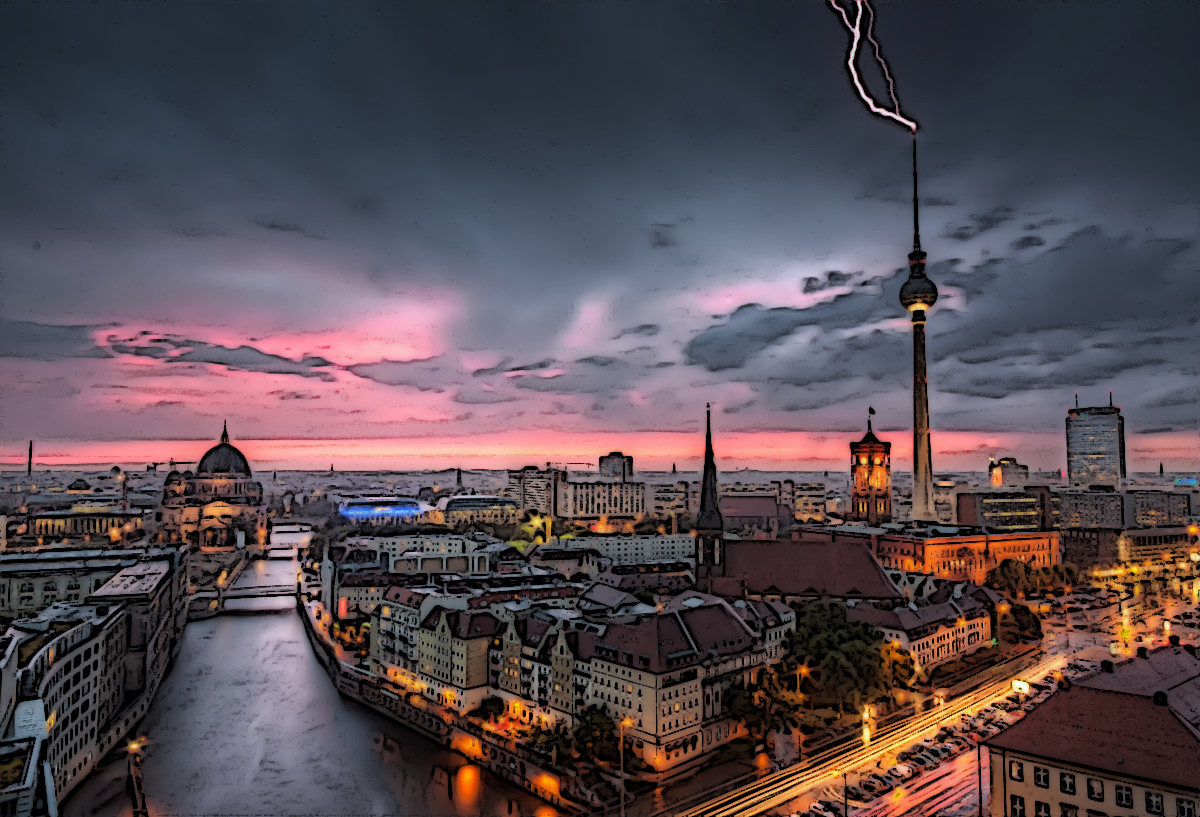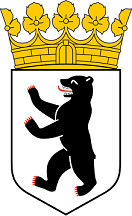Berlin
The decision has to be made. You cannot long roam the streets without choosing sides, but the choices are not as simple as they should be; to the east is certain security with the only cost being your freedom. To the west there is so much more you can do, and so many more dangers as well.
One city with two princes, and both demanding fealty, both promising protection from the anarchs and each other. Both watching over your every move. To the east is silence; to the west, the noises of drunken revelry. From both directions you can feel the eyes watching as, behind you, screams of pain echo through the night.
Contents
- 1 Eine Einführung: An Introduction
- 2 Quote
- 3 Appearance
- 4 City Device
- 5 Climate
- 6 Districts
- 7 Das Wörterbuch: The Dictionary
- 8 Demonym
- 9 Economy
- 10 Geography
- 11 Der Geschichte Berlins: History of the City
- 12 Population
- 13 Arenas
- 14 Attractions
- 15 Bars and Clubs
- 16 Cemeteries
- 17 City Government
- 18 Crime
- 19 Die Sterblichen Massen: Mortal Society
- 20 Current Events
- 21 Foreign Consulates (149)
- 22 Fortifications
- 23 Galleries
- 24 Holy Ground
- 25 Hospitals
- 26 Hotels & Hostels
- 27 Landmarks
- 28 Law Enforcement
- 29 Maps
- 30 Mass Media
- 31 Monuments
- 32 Multinational Corporations
- 33 Museums
- 34 Parks
- 35 Private Residences
- 36 Restaurants
- 37 Ruins
- 38 Schools
- 39 Shopping
- 40 Telecommunications
- 41 Theaters
- 42 Transportation
- 43 Die Gesetze der Nacht: The Traditions
- 44 Die Untoten: The Vampires of Berlin
- 45 Die Erwachten: The Awakened of Germany
- 46 Websites
- 47 Errata
Eine Einführung: An Introduction
The kine have their eyes on all Europe, but perhaps nowhere as strongly as they do Germany. The Camarilla cannot permit this endless squabbling between the Eastern and Western factions to continue. The fools endanger the Masquerade and the peace the Camarilla embodies. If East and West cannot live in peace, if they cannot settle their disputes promptly and quietly, then we must settle their affairs for them. One almost expects such foolishness in the New World, but we cannot allow anarchy to reign in any part of our own continent. If necessary, we must choose their ruler for them and destroy any who would oppose us. -- Karl Schrekt, Justicar of Clan Tremere. {circa: 1987}
Berlin prospered for centuries under the rule of Gustav, a harsh and strict prince who tolerated no disobedience. For centuries the city had a small but powerful Kindred population which ruled over all mortal matters of importance without fear of retribution; Gustav upheld the Masquerade and none dare defy him.
Then came the end of the Second World War. The vast majority of the city's Kindred met Final Death during the bombings, destroyed by the savage explosions that rocked the entire city to its foundations. The city of Berlin was divided by the humans of other countries and, for the first time in more than six-hundred years, Gustav lost the iron rule of his domain, forced by the Canaille to stay in the eastern part of his city.
Its builders did not designed the Berlin Wall to stop Kindred, but Wilhelm, usurper to Gustav's throne in the west, convinced the Tremere to create a mystical barrier strong enough to stop the passage of all but the most powerful or crafty Kindred. Now the Wall has come down; Brujah no longer rule over the Eastern Bloc of Europe and many of their elders have disappeared.
The magical barrier has been weakened as well, damaged as revelers dismantled the wall. Gustav is ready to take back what is rightfully his, using any means necessary. Wilhelm, once Gustav's trusted aide, now prince of the western half of the city, has other ideas. Wilhelm has changed the rules in Berlin, allowing the creation of progeny, unrestricted travel by Kindred from other domains, and the growth in both the numbers and power of the anarchs.
During Wilhelm's rule, West Berlin has become a metropolis and a thriving convention city, hosting well over one-thousand conventions annually. He has no intention of surrendering his domain to the prince of the East, for the city has prospered under his rule, both for the Kindred and the kine alike.
And so it is war. The East Berliners fight to regain what was once theirs and the West Berliners fight to keep the power that they have gained for themselves. Berlin continues to coexist by day, slowly adjusting to a situation much changed by the reunion of its divided halves. While the people of Berlin -- and all of Germany -- have greeted long lost relatives with open arms and begun forging a greater nation, the struggle is not over. Now that the first glow has faded, everyone must deal with two generations of different laws and lifestyles that have left an indelible mark on both halves.
By night, Berlin is a political hotbed of intrigue and violence. Kindred guard borders that no longer exist for humans; vampires fight amongst themselves, deciding where they will hunt, where they will sleep and which prince is the true leader of Berlin. So far the damage has been minor, but that is bound to change. Neither prince will yield in this bitter dispute and neither will surrender a meter of territory; both remain unsatisfied with only half a city.
New faces appear nightly. Anarchs run freely through the western part of town, giving grudging respect to Wilhelm's laws but threatening to bring the turbulent situation to the notice of the Camarilla. Choices must be made; a final decision of who will be prince is all that will keep the Camarilla and its Justicars from crushing this growing freedom. Who will you follow, who will you defy? How can you truly be certain which prince is the right one, when the loser will almost certainly forfeit his immortal unlife?
Now trapped in the East, Gustav ruled Berlin for six-hundred years. During his reign none dared break the laws. The Camarilla had no reason to examine Berlin.
In the West, Wilhelm is a kinder prince, but anarchs are showing what too much Kindred freedom can do. The Camarilla carefully watches for any signs of serious trouble.
Individual Kindred have already decided who they want to rule in Berlin, but they do not talk of these things. They simple wait for your decision to be made. Will they welcome your coterie or destroy you? There can be no election, but every Kindred's opinion matters for more important issues than just who will rule. Every Kindred's opinion could well determine who lives another night.
All of Berlin's Kindred will be watching your coterie and it's every move; all the Kindred await their decision. Which way will they turn? Who will be their prince...or will they even allow a prince to rule them?
Quote
"We like our Berlin immensely -- an ugly place it must be to anyone who comes to it hipped or solitary..." -- George Elliot
Appearance
City Device
Climate
Berlin has a Maritime temperate climate according to the Köppen climate classification system. There are significant influences of mild continental climate due to its inland position, with frosts being common in winter and there being larger temperature differences between seasons than typical for many oceanic climates. Summers are warm and sometimes humid with average high temperatures of 22–25 °C (72–77 °F) and lows of 12–14 °C (54–57 °F). Winters are cool with average high temperatures of 3 °C (37 °F) and lows of −2 to 0 °C (28 to 32 °F). Spring and autumn are generally chilly to mild. Berlin's built-up area creates a microclimate, with heat stored by the city's buildings and pavement. Temperatures can be 4 °C (7 °F) higher in the city than in the surrounding areas.
Annual precipitation is 570 millimeters (22 in) with moderate rainfall throughout the year. Snowfall mainly occurs from December through March.
Districts
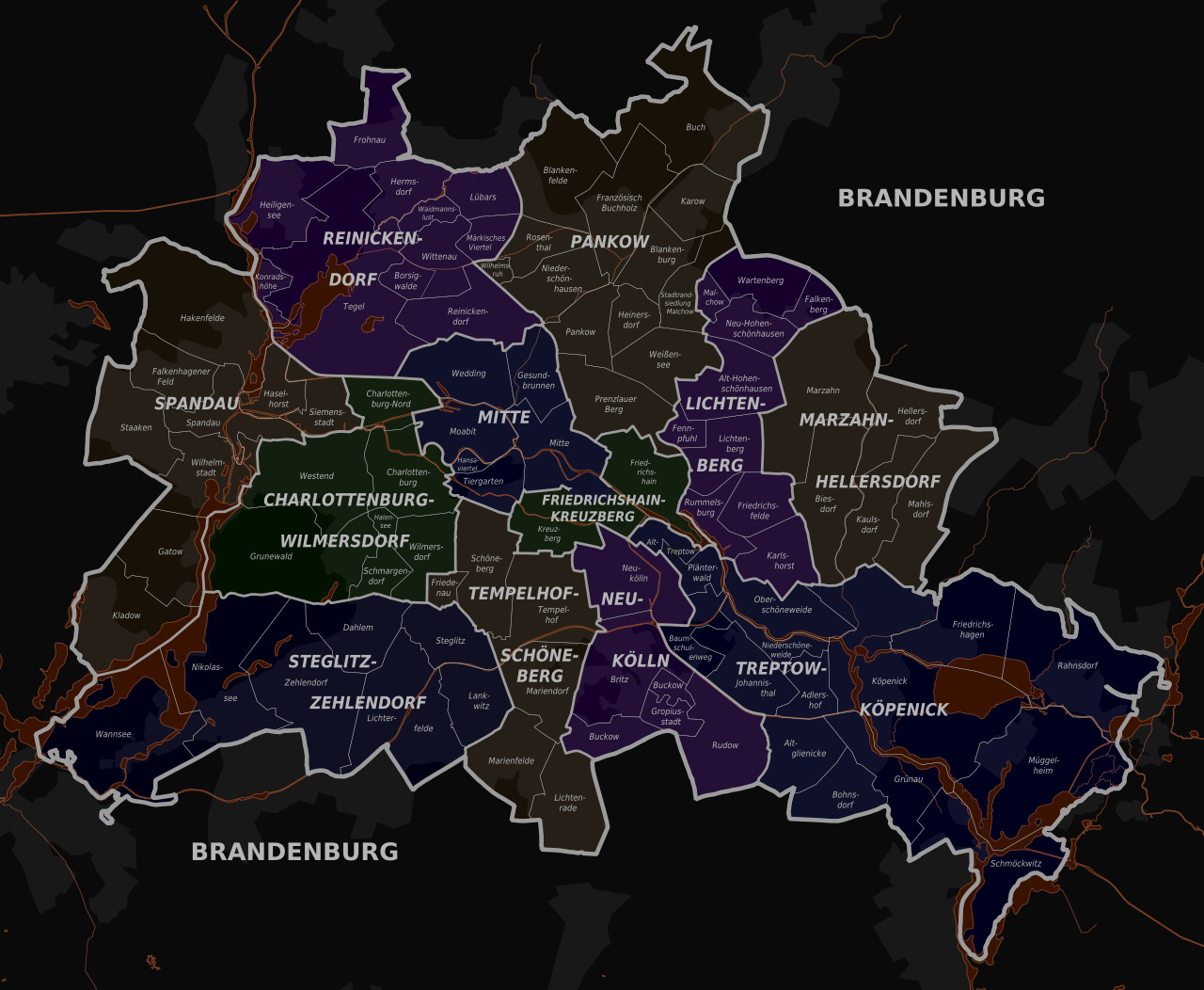
The modern city of Berlin has twenty districts, twelve in the west and eight in the eastern section of the city. In the mortal world, there districts are just smaller subsections of the greater metropolitan Berlin; to the Kindred way of thinking, things are a bit different, as each of these districts are lesser duchies ruled by an undead despot who owes his or her allegiance to the respective prince of east or west. The powerful undead who call these districts home are often jokingly refered to as burgomeisters; though over the last few decades the term has begun to lose its humorous conotation and has started to take on real authority as the struggle between the two princes of the city continues to erode the inherent authority of the princedom. As with every other facet of Berlin, the city's districts are divided into eastern and western, as seen below. Though the Burgomeisters are theoretically bound by the authority of their respective liege, the reality of the situation can often be something different alltogether; visitors to Berlin are advised to treat the Burgomeisters with respect, for in the absense of centralized power - accidents happen.
Ost-Berliner: East Berlin
- -- Friedrichshain
- -- Kopenick
- -- Lichtenberg
- -- Mitte
- -- Pankow
- -- Prenzlaur Berg
- -- Treptow
- -- Weisensee
West-Berliner: West Berlin
- -- Charlottenburg
- -- Kurfurstendamm
- -- Gropiusstadt
- -- Grunewald
- -- Kreuzberg
- -- Neukolln
- -- Pfauseninsel
- -- Reinickendorf
- -- Schoneberg
- -- Sterglitz, Steglitz-Zehlendorf
- -- Spandau
- -- Tempelhof
- -- Zehlendorf
Das Wörterbuch: The Dictionary
Demonym
Berliner
Economy
Geography
Topography
Berlin is situated in northeastern Germany, in an area of low-lying marshy woodlands with a mainly flat topography, part of the vast Northern European Plain which stretches all the way from northern France to western Russia. The Berliner Urstromtal (an ice age glacial valley), between the low Barnim Plateau to the north and the Teltow Plateau to the south, was formed by meltwater flowing from ice sheets at the end of the last Weichselian glaciation. The Spree follows this valley now. In Spandau, a borough in the west of Berlin, the Spree empties into the river Havel, which flows from north to south through western Berlin. The course of the Havel is more like a chain of lakes, the largest being the Tegeler See and the Großer Wannsee. A series of lakes also feeds into the upper Spree, which flows through the Großer Müggelsee in eastern Berlin.
Substantial parts of present-day Berlin extend onto the low plateaus on both sides of the Spree Valley. Large parts of the boroughs Reinickendorf and Pankow lie on the Barnim Plateau, while most of the boroughs of Charlottenburg-Wilmersdorf, Steglitz-Zehlendorf, Tempelhof-Schöneberg, and Neukölln lie on the Teltow Plateau.
The borough of Spandau lies partly within the Berlin Glacial Valley and partly on the Nauen Plain, which stretches to the west of Berlin. Since 2015, the highest elevation in Berlin is found on the Arkenberge hills in Pankow, at 122 m (400 ft). Through the dumping of construction debris, they surpassed Teufelsberg (120.1 m), a hill made of rubble from the ruins of the Second World War.[60] The highest natural elevation is found on the Müggelberge at 114.7 m, and the lowest at the Spektesee in Spandau, at 28.1 m (92 ft).
Cityscape
Berlin's history has left the city with a highly eclectic array of architecture and buildings. The city's appearance today is predominantly shaped by the key role it played in Germany's history in the 20th century. Each of the national governments based in Berlin – the Kingdom of Prussia, the 1871 German Empire, the Weimar Republic, Nazi Germany, East Germany, and now the reunified Germany – initiated ambitious reconstruction programs, with each adding its own distinctive style to the city's architecture.
Berlin was devastated by bombing raids, fires and street battles during World War II, and many of the buildings that had remained after the war were demolished in the post-war period in both West and East Berlin. Much of this demolition was initiated by municipal architecture programs to build new residential or business quarters and main roads. Many ornaments of pre-war buildings were destroyed following modernist dogmas. While in both systems and in reunified Berlin, various important heritage monuments were also (partly) reconstructed, including the Forum Fridericianum with e.g., the State Opera (1955), Charlottenburg Palace (1957), the main monuments of the Gendarmenmarkt (1980s), Kommandantur (2003) and the project to reconstruct the baroque façades of the City Palace. A number of new buildings is inspired by historical predecessors or the general classical style of Berlin, such as Hotel Adlon.
Clusters of high-rise buildings emerge at e.g., Potsdamer Platz, City West and Alexanderplatz. Berlin has three of the top 40 tallest buildings in Germany.
Der Geschichte Berlins: History of the City
Humans, led by Albrecht (al-Brecht) the Bear, first settled the area now called Berlin in A.D. 1134. Albrecht became markgraf (count) of the area, then known as the Northern March or Nordmark.
The region's Kindred made their presence known within three years.
Population
- -- City (7,415,091) - 31 October 2040 census
Arenas
Attractions
Bars and Clubs
Cemeteries
- -- Friedhof Heerstrabe
- -- British War Cemetery
- -- Kreuzberg, Holy Trinity Cemetery I
- -- Kreuzberg, Jerusalem und Neue Kirche III
- -- Kreuzberg, Luisenstädtischer Friedhof
- -- Lichtenberg, Zentralfriedhof Friedrichsfelde.
- -- Mitte, Dorotheenstädtischer Friedhof. Burial site of Georg Wilhelm Friedrich Hegel
- -- Niederschönhausen, Friedhof Pankow III
- -- Schöneberg, Städtischer Friedhof III.
- -- Schöneberg, Alter St.-Matthäus-Kirchhof Berlin. Burial site of the Brothers Grimm
- -- Weibensee, Weißensee Cemetery. A large Jewish cemetery which mainly survived Nazism and the DDR.
- -- Wilmersdorf, Friedhof Schmargendorf.
- -- Zehlendorf, Städtischer Friedhof Berlin-Zehlendorf.
- -- Zehlendorf, St Annen Friedhof, Dahlem Dorf.
- -- Zehlendorf, Cemetery Dahlem.
- -- Zehlendorf, Waldfriedhof Dahlem, Hüttenweg.
- -- Zehlendorf, Waldfriedhof Zehlendorf, Potsdamer Chaussee.
City Government
Crime
Arab Mafia
Die Welt reported in 2016 that Berlin and Bremen have significant problems with organised crime in the form of "Arab Families," of which seven to nine[3] are criminally conspicuous and today "control most of organised crime." For example, the prostitutes in the Schöneberg neighbourhood are controlled by one family. Disputes are solved through mutually agreed mediators, who can include imams and heads of families.
Italian Organized Crime
The 'Ndrangheta, Camorra and Cosa Nostra all operate in Germany; the 'Ndrangheta has the strongest presence. There are some estimated 1200 members of the Ndrangheta active in Germany, mostly in the cocaine trade. Apart from the Ndrangheta, the Neapolitan Camorra has also infiltrated the construction industry in Germany. Furthermore, there are also five Sicilian mafia groups active in the country, but they seem to have lost power. Italian crime groups can mostly be found in the Ruhr district and in the east of Germany. Outlaw Motorcycle Gangs
OMCG's such as Hells Angels, Bandidos, Gremium and more recently, Satudarah, Night Wolves are active throughout Germany. While not all members of motorcycle clubs are criminal, some are reputed to be well known faces in the red-light districts and in the bouncer-scene who control a large chunk of the drug trade within bars and clubs.
Albanian mafia
Albanian mafia families are active in some of the German urban centres, in particular Hamburg. They play an important role in the drug trade and the red light districts of the country.
"Ethnic Albanians" (as the German police officially calls them), who come into Germany typically from Albania or the Republic of Macedonia or Kosovo, have created a very powerful criminal network. Albanian "banks" in Germany are a special story. They are used for the transfer of money from Germany, which amounts to a billion of D-marks a year. The money laundering by these criminals is efficient and relatively clean. While mortal society has tried, they have yet to pierce the veil of the Albanian banks.
BND reports state that Albanian Mafia activities are thoroughly spread throughout Germany. The clan has considerable ties to police, judges and prosecutors in Hamburg.
Russian mafia
Russian-speaking crime groups, in particular the Tambov gang are active in cities such as Düsseldorf. Especially money laundering, prostitution and extortion seem to be their activities of choice. Russian criminal activity doesn't only concern ethnic Russians but also Russian Jews. Aside from the Russian groups, Georgian, Azerbaijani and Chechen crime groups are active in Germany as well. Very often these gangs and the Russian groups are named together in one breath even when they have little to do with each other.
Another major form of Russian-speaking organized crime in Germany consists of so-called criminal Aussiedler families. Aussiedlers are ethnic Germans (also called Volga Germans) that were born in the former Soviet Union. While a lot of Aussiedlers adapted well and quickly mastered the German language, a lot of families held unto the traditional lifestyle they lived in Russia and surrounding states. This led to the formation of individual as well as clan-based groups of Aussiedlers involved in organized criminal activities such as drug trafficking, extortion, prostitution,...as well as extreme violence. Due to the large number of Aussiedlers they are seen as the major form of Russian organized crime in Germany.
Serbian mafia
The Zemun clan is active in Germany in drug trafficking and prostitution. Members are largely ethnic Serbs, some of them former soldiers, but Montenegrins and Bosniaks from the Serbian region of Sandzak are part of the ex-Yugoslavian gangs as well.
Turkish and Kurdish organized crime
Turkish crime groups which consist of ethnic Turks and/or ethnic Kurds from Turkey are active throughout Germany in extortion, weapon trafficking and drug trafficking. Often the gangs can be linked to political groups from their home country, such as the Grey Wolves for right-wing Turks and Dev Sol for left-wing Turks and Kurds.
Middle Eastern crime clans
Middle Eastern crime clans have become a major player in the underworld of Germany since the mass emigration of large Middle Eastern families, also called Großfamilie. Especially in cities such as Berlin, Hamburg and Bremen Middle Eastern clans are highly active in the trafficking of heroin as well as being involved in the bouncer-scene. Middle Eastern crime families mostly have origins in Lebanon, Afghanistan (mainly in Hamburg) and Morocco (mostly in Frankfurt).
Middle Eastern crime clans come from different backgrounds, but the most numerous of them are the Lebanese Mhallami clans such as the Al-Zein Clan and the Miri clan among others. Lebanese clans are active in drug trafficking, including Afghan heroin, cocaine, hashish and methamphetamine, weapon trafficking, extortion, prostitution and loan sharking. The main center of Lebanese organized crime in Germany is Berlin, with other clans spread in Bremen and Essen.[10][11]
Afghan criminal clans (often of Pathan background) are active in Hamburg, a city with a large Afghan population. Like the Turkish and Turkish-Kurdish as well as Albanian gangs in the city, Afghan organized crime is active in hashish and heroin trafficking, extortion and prostitution.
Moroccan organized crime groups, often of Riffian descent, on the other hand have been reported in Frankfurt. Next to Serbian mafia and Balkan gangs, Moroccan organized crime has become one of the main factors in the Frankfurt underworld active in the heroin trade as well as other criminal activities.
Vietnamese crime groups
Vietnamese groups active in human trafficking and cigarette smuggling have been reported in Germany. Chinese Triads on the other hand have been reported but don't seem to have substantial power in Germany
Die Sterblichen Massen: Mortal Society
Current Events
Foreign Consulates (149)
Fortifications
Galleries
Holy Ground
Hospitals
- Charité - Universitätsmedizin Berlin
- DRK Kliniken Berlin Westend
- St. Joseph-Krankenhaus
- Franziskus-Krankenhaus
- Martin Luther Hospital
- Meoclinic
- Unfallkrankenhaus Berlin
- Vivantes Klinikum im Friedrichshain: Geburtsmedizin
Hotels & Hostels
Landmarks
- -- The Brandenburg Gate
- -- The Europa Center -- Elysium
- -- Gendarmenmarkt
- -- International Congress Center -- Elysium
- -- The Kaiser Wilhelm Memorial Church -- Elysium
- -- Reichstag Building
Law Enforcement
The Berliner Polizei (Berlin Police) is the German Landespolizei force for the city-state of Berlin. Law enforcement in Germany is divided between federal and state (Land) agencies.
Maps
Mass Media
Monuments
- -- Victory Tower
Multinational Corporations
Museums
Berlin has a surprising number of museums that stay open past dark, and Kindred can visit without the necessity of Dominating or bribing a guard for the privilege. While most still close by six P.M., a number of toreador favorites have certain rights when they remain open well beyond sunset.
For example, the Berlin Film Museum is open on Wednesdays and Saturdays until 11 P.M. for the express purpose of showing historic films, and the Berlin National Art Gallery remains opn until 10 P.M. every night. for obvious reasons, the Prince of West Berlin insists on a strict rule of Elysium in these museums and, at the insistence of the Toreador elder, has included all other museums as well. the toreador normally spend a good deal of their time in the museums and will enforce the Elysium at any cost.
The only way to gain entrance to other museums after dark is to Dominate or bribe the guards that work there; most of the Kindred simply do not believe that the reward gained in these circumstances is worth the effort involved. The Toreador have managed to gain access to all of the museums in Berlin, and as often as not have havens inside them in case of emergencies. the one possible exception to this rule is the Egyptian Museum.
While East Berlin also has a number of museums, these are not as strongly protected for the simple reason that there are no Toreador save Thomas De Lutrius in the eastern half of the city. Gustav's long-lasting grudge against the clan has kept them from repopulating the city since World War II, and Gustav has almost always found a way to either exile visiting Toreador or gather evidence to support having them killed.
The one museum excepted from this, and which toreador from around theEastern Block used to visit, is the Otto-Nagel Haus, a "proletarian revolutionary art museum" open on Wednesdays until 10 P.M. Wednesday is the one night of the week in which a Toreador may walk through Easter Berlin without fear of molestation, provided he or she has presented themselves to the Prince.
Museum Locations
Kruezberg
Mitte
Museum Island
- -- Altes Museum: Roman and Greek Classical Antiquities
- -- Alte Nationalgalerie: 19th century sculptures and paintings.
- -- Bode-Museum: the Numismatic Collection, Sculpture Collection and the Museum of Byzantine Art
- -- Neues Museum: the Egyptian Museum of Berlin and its Papyrus Collection, and the Museum für Vor- und Frühgeschichte (Prehistory and Early History)
- -- Pergamon Museum: the Antikensammlung Berlin, Museum of Islamic art, Museum of the Ancient Near East and the Central Archive
- -- Friedrichswerder Church: early 19th century sculptures
Tiergarten/Moabit
- -- Kulturforum
Charlottenburg
- -- Brohan Museum -- Elysium
- -- Museum Berggruen: classic modern art
- -- Museum of Photography / Helmut Newton Foundation
- -- Museum Scharf-Gerstenberg: surrealist art
- -- Gipsformerei (Replica workshop)
Dahlem
Ethnological Museum of Berlin: American Archaeology, Music Ethnology, North American Indians, South Sea, East Asia, Africa, Junior Museum Museum of Asian Art: Collection of South, Southeast and Central Asian Art; Collection of East Asian Art Museum Europäischer Kulturen: European Cultures
Köpenick Palace
Kunstgewerbemuseum: Museum of decorative art
Berlin State Library
Two locations, Haus Unter Den Linden and Haus Potstdamer Straße, are open to the public; various others are not.
Parks
Private Residences
Restaurants
Ruins
Schools
Shopping
Telecommunications
Theaters
Transportation
Trains
- -- Berlin Hauptbahnhof -- Berlin's premier railway station. Located in Mitte.
- -- Berlin Ostbahnhof -- Translated from German to English as Berlin East railway station. It is the second of two main line railway stations in Berlin, located in Friedrichshain.
- -- Bahnhof Berlin Zoologischer Garten -- is the smallest railway station in Berlin. It is located on the Berlin Stadtbahn railway line in the Charlottenburg district, adjacent to the Berlin Zoo. {Western most terminal for the Trans-Siberian Railway linking Germany to Russia}
Planes
Automobiles
Die Gesetze der Nacht: The Traditions
The First Tradition: The Masquerade
Thou shall not reveal thy nature to those not of the Blood. Doing so shall renounce thy claims of Blood.
The Second Tradition: The Domain
Thy domain is thine own concern. All others owe thee respect while in it. None may challenge thy word while in thy domain.
The Third Tradition: The Progeny
Thou shall sire another only with the permission of thine elder. If thou createst another without thine elder's leave, both thee and thy progeny shall be slain.
The Fourth Tradition: The Accounting
Those thou create are thine own childer. Until thy progeny shall be released, thou shall command them in all things. Their sins are thine to endure.
The Fifth Tradition: Hospitality
Honor one another's domain. When thou comest to a foreign city, thou shall present thyself to the one who ruleth there. Without the word of acceptance, thou art nothing.
The Sixth Tradition: Destruction
Thou art forbidden to destroy another of thy kind. The right of destruction belongeth only to thine elder. Only the eldest among thee shall call the blood hunt.
Die Untoten: The Vampires of Berlin
"The kine have their eyes on all Europe; but perhaps nowhere as strongly as they do Germany. The Camarilla cannot permit this endless squabbling between the Eastern and Western factions to continue. The fools endanger both the Masquerade and the peace the Camarilla embodies. If East and West cannot live in peace, if they cannot settle their disputes promptly and quietly, then we must settle their affairs for them. One almost expects such foolishness in the new world, but we cannot allow anarchy to reign in any part of our own continent. If necessary, we must choose their ruler for them and destroy any who would oppose us." -- Karl Schrekt, Former Justicar of Clan Tremere
Das östliche Gericht: The Eastern Court
Brujah
 Dieter Kotlar -- Der Krieger Dieter Kotlar -- Der Krieger
|
 Erika Geiger -- Die Fanatic Erika Geiger -- Die Fanatic
|
 Dietmar Vogel -- Verrückter Wissenschaftler Dietmar Vogel -- Verrückter Wissenschaftler
|
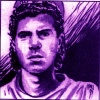 Stefan Rutigar -- Die Faust Stefan Rutigar -- Die Faust
|
Gangrel
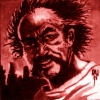 -- Daryl Lutz -- Das wilde Tier
-- Daryl Lutz -- Das wilde Tier
(The Feral One)
Malkavian
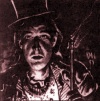 Oswald White -- Ozzy Oswald White -- Ozzy
|
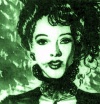 Persia -- Die schöne Statue Persia -- Die schöne Statue (The Beautiful Statue) |
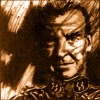 Hermann Goring -- Flüstern in der Nacht Hermann Goring -- Flüstern in der Nacht (Whispers in the Night) |
Toreador
 -- Thomas De Lutrius -- Der gequälte Künstler
-- Thomas De Lutrius -- Der gequälte Künstler
(The Painter in Pain)
Tremere
- -- Frederick Werther -- The "Little" Regent of the East
Ventrue
- -- Gustav Breidenstein -- Prince of East-Berlin
- -- Katarina Kornfeld -- The Loyal Childe
- -- Parsifal Wildgrube -- Court Page
Das Western-Gericht: The Western Court
Brujah
Gangrel
Malkavian
- -- Henry Jekyll -- The Doctor.
Nosferatu
Toreador
- -- Anntoinette
- -- Hans Vroenik
Tremere
- -- Heinrich Himmler -- Apprentice to Ldescu.
- -- Maxwell Ldescu -- The Warlock Regent of the West.
- -- Marzell Trumbauer -- Resident Astor.
- -- Wolfram -- Elder Gargoyle of Berlin.
- -- Ruprecht -- Gargoyle
- -- Thorben -- Gargoyle
- -- Gotthold -- Gargoyle
- -- Falk -- Gargoyle
Ventrue
- -- Wilhelm Waldburg -- Prince of West Berlin
- -- Nichole
- -- Irmingard Kopp -- Court Ambassador
Nosferatu: Mercenary Agents of Neutrality
 Melitta Wallenberg -- Die verführerische Kanalratte Melitta Wallenberg -- Die verführerische Kanalratte
|
 Ellison -- Die Wahrheit in den Mauern Ellison -- Die Wahrheit in den Mauern
|
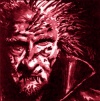 Ugly Rasputin -- Die unaufhaltsamen Wut Ugly Rasputin -- Die unaufhaltsamen Wut
| |
 Amelia -- Die weinende Frau Amelia -- Die weinende Frau
|
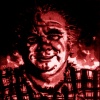 Wolfgang -- Die wahnsinnigen Lachen Wolfgang -- Die wahnsinnigen Lachen
|
Die Unerwünschten: The Caitiff
Diejenigen Ausländischen Blut: Foreign Kindred
Die Anhänger Set
- -- Nefertiti -- Progeny of Set. Sire of Aabt Kindred. Self-Proclamed Queen of Europe.
Fraktionen in der Jyhad: The Sects
- -- Anarchs
- -- Bolsheviks -- A largely Brujah organization of vampiric revolutionaries.
- -- Final Reich
- -- Camarilla
- -- Sabbat
- -- Inconnu
Die Erwachten: The Awakened of Germany
Websites
http://en.wikipedia.org/wiki/Berlin
Errata
